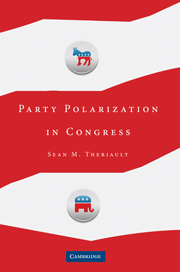PART I - BUILDING BLOCKS FOR EXPLAINING PARTY POLARIZATION
Published online by Cambridge University Press: 05 September 2012
Summary
Part I of this book provides the base from which my polarization argument builds in parts II and III. Chapter 2 lays out a systematic description of party polarization and how it has varied over time. The twentieth century began with parties that were even more polarized than the parties today, but the ideological gap between them narrowed for much of the twentieth century. Beginning in the early 1970s, however, members of both parties in both chambers began casting more divisive votes. Chapter 3 places the existing explanations for this increased polarization over the past three decades into a comprehensive model that is then rigorously analyzed in the remainder of the book.
Information
- Type
- Chapter
- Information
- Party Polarization in Congress , pp. 11 - 12Publisher: Cambridge University PressPrint publication year: 2008
